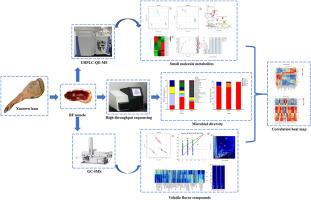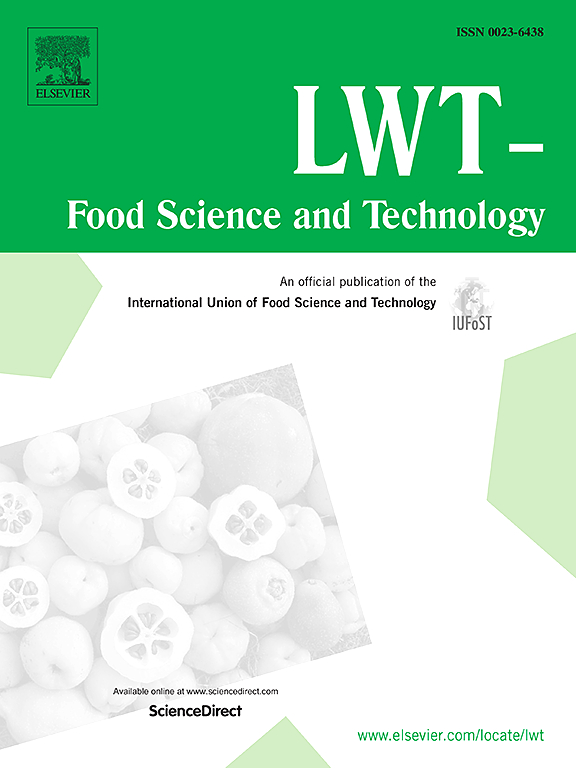Revealing the correlation between small molecule metabolites, volatile compounds and microbial communities during the ripening of Xuanwei ham
IF 6
1区 农林科学
Q1 FOOD SCIENCE & TECHNOLOGY
引用次数: 0
Abstract
To elucidate the impact of microorganisms on the metabolites and flavor of Xuanwei ham, the correlation between volatile compounds, small molecule metabolites, and microbial communities in Xuanwei ham was studied. The results showed that the predominant bacteria and fungi were Proteobacteria, Firmicutes, and Ascomycota, respectively at the phylum level, and the main bacteria was Staphylococcus, and the predominant fungi was Aspergillus at the genus level. A total of 48 differential metabolites were screened, and amino acids were the most abundant. Upon pathway analysis, 21 metabolic pathways were found to be related to ham ripening. More than 20 key metabolites such as arginine were accurately matched by Public Chemistry Database (Pub Chem) and Kyoto Encyclopedia of Genes and Genomes (KEGG). Eighteen volatile flavor characteristic compounds were identified, and the relative content of acetone in ham samples from various years was the highest. Additionally, the findings explored the relationship between small molecule metabolites, volatile compounds, and microorganisms in Xuanwei ham, which showed that the microorganisms in the samples had a positive effect on a variety of amino acids and alcohols. The findings represent a fertile ground for the formation of ham quality.

揭示宣威火腿成熟过程中的小分子代谢物、挥发性化合物和微生物群落之间的相关性
为阐明微生物对宣威火腿代谢物和风味的影响,研究了宣威火腿中挥发性化合物、小分子代谢物与微生物群落之间的相关性。结果表明,在菌门水平上,主要的细菌和真菌分别为蛋白菌门、真菌门和子囊菌门;在菌属水平上,主要的细菌为葡萄球菌,主要的真菌为曲霉菌。共筛选出 48 种差异代谢物,其中氨基酸含量最高。通过途径分析,发现有 21 条代谢途径与火腿成熟有关。精氨酸等 20 多个关键代谢物与公共化学数据库(Pub Chem)和京都基因与基因组百科全书(KEGG)准确匹配。鉴定出 18 种挥发性风味特征化合物,其中不同年份火腿样品中丙酮的相对含量最高。此外,研究还探讨了宣威火腿中的小分子代谢物、挥发性化合物和微生物之间的关系,结果表明,样品中的微生物对多种氨基酸和醇类有积极影响。这些发现为火腿品质的形成提供了肥沃的土壤。
本文章由计算机程序翻译,如有差异,请以英文原文为准。
求助全文
约1分钟内获得全文
求助全文
来源期刊

LWT - Food Science and Technology
工程技术-食品科技
CiteScore
11.80
自引率
6.70%
发文量
1724
审稿时长
65 days
期刊介绍:
LWT - Food Science and Technology is an international journal that publishes innovative papers in the fields of food chemistry, biochemistry, microbiology, technology and nutrition. The work described should be innovative either in the approach or in the methods used. The significance of the results either for the science community or for the food industry must also be specified. Contributions written in English are welcomed in the form of review articles, short reviews, research papers, and research notes. Papers featuring animal trials and cell cultures are outside the scope of the journal and will not be considered for publication.
 求助内容:
求助内容: 应助结果提醒方式:
应助结果提醒方式:


